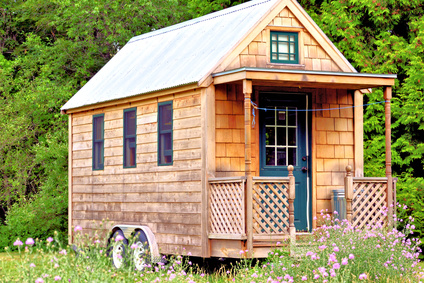The tiny house movement is really taking off across America and it’s making headway in Europe. There are some amazing tiny house designs out there, fully functional houses with many mod cons- just tiny versions that make great use of space.

The small house movement is primarily a social movement, but is architecturally important too. The movement is simply about people living in small homes. There isn’t a set definition about how small a small home is but they are usually less than 400 square feet. There are some fabulous tiny home constructions out there, fully fitted, plumbed and lit!
The modern day tiny home movement began around 1997 and developed for many reasons such as the astronomical cost of real estate in the cities, homelessness, sustainability, ecologically friendliness and the cost of running a regular home. The tiny homes are usually built to promote community and decrease materialism by getting back to a simpler way of life.
Types of Tiny Homes
There are many types of homes that could be considered tiny, such as RVs, static caravans, trailers, homes on wheels and even Traveller caravans. But here ‘tiny homes’ is referring to static homes, those built out of shipping containers, pre fab kits and build to order homes. The homes are really just scaled down models of regular homes, with a living space, kitchen and bathroom.
Currently tiny houses are a very small part of the real estate market, in the USA only 1% of homeowners purchase homes of less than 1000 square feet. The tiny houses cost between $20,000- $50,000 much less than a standard home. Of course you can design a tiny home for whatever you want and some cost upwards of $150,000.
The idea of living sustainably and creating the smallest footprint possible sounds great but there are certain things I really wouldn’t want to live without. One is running water and the other is a flushing toilet! Many moveable small homes use compostable toilets, chemical toilets, collect rainwater or dig a well. But if your small home is more or less static you can hook up your tiny home to the public water source and you'll have the water you need!
It is possible to connect your tiny home to the city’s sewer system to get rid of wastewater and sewerage. It can be a bit complicated if you try to do it yourself but it is totally possible. Personally I would find a plumber specialised in small homes. The other option to a flushable toilet is a composting toilet; these don’t smell and are ecologically friendly.
The good thing about tiny house plumbing is that it is easy to test, fix and install, but it can just as easily go wrong so frequent checking and maintenance is a good idea! The good thing about tiny house plumbing is that it is easy to test, fix and install, but it can just as easily go wrong so frequent checking and maintenance is a good idea! Regular sewer cleaning must also be done to avoid sewage backups and other related problems.
If you are looking to downsize and live a simpler, environmentally friendly life in these days of climate breakdown, maybe a small home would suit you? There is plenty of choice of ‘on grid’ or ‘off grid tiny homes’ depending on what you want. The uniquely designed ones and the ones with the best amenities are definitely on grid- but that’s only my opinion!
Here are 10 tips for building tiny houses that meet the zoning laws of your region.
Electricity and plumbing: Based on estimates, owners of tiny homes may spend around $1,000 on plumbing and $300 on wiring, but this cost depends on whether you'll be living on or off the grid. Many tiny houses are solar-powered with no connection to main sewer or water lines.
In the world of tiny houses, composting toilets are what everyone uses. A composting toilet, unlike conventional toilets, doesn't need plumbing and doesn't flush the sewage away. Instead, the waste stays on site and gets composted on site (and no, there's no smell!).